Tumble Bug
Inductee Hall of Fame December 2015
Black dog (Menang – Proposed), Whelped January 1945 Owner/Trainer Cliff J.Abraham
This famous chaser from the most humble beginnings in Moonah, set the Greyhound world alight in his all too brief career, then rocketed to such stardom as a sire, that he was inducted into the U.S.A. Greyhound Racing Hall of Fame.
So influential was Tumble Bug, that Gary Guccione, the Executive Director of the National Greyhound Association of the U.S.A., and himself a Hall of Famer (2009), devoted an entire chapter to this freak chaser in one of the volumes of his 1980’s “ Great Names in Greyhound Pedigrees”. So, most fittingly and appropriately, much of the Tumble Bug tribute will be extractions from his fine writings.
Part one of Tumble Bug will relate to his racing career, which sadly spanned a mere 27 starts for 18 wins, 2 seconds and 3 thirds. Part two will be the irresistible Guccione stud tribute.
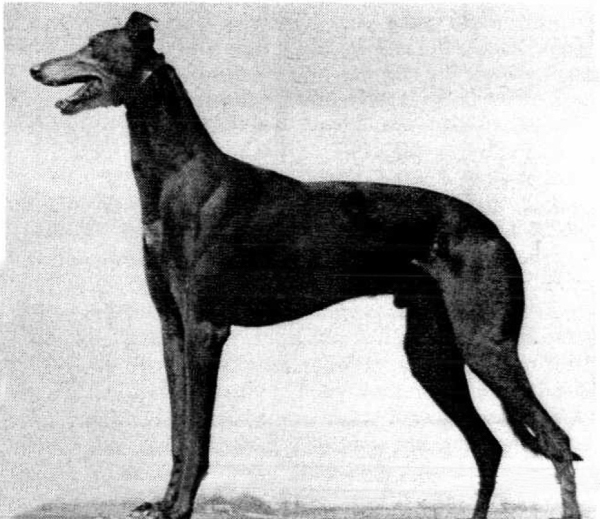
The great Tumble Bug himself
Syrian born Cliff Abraham spent most of his training years in N.S.W. but during the mid 1940’s lived in Heffernan Street in the northern Hobart suburb of Moonah. Friend and fellow breeder Merv Watson, who lived nearby in Station Street Moonah, whelped down Abraham’s Menang – Proposed litter in January 1945. Cliff Abraham had raced the dam with some success and gave great thought into his choice of sire, determined to breed a champion. Two great chasers emerged from the litter of eight, they being Tumble Bug and his brilliant brother Chesterman. Tumble Bug was originally sold on time payment to a friend, but was such a creator of upheaval, and so high spirited, he was returned to Abraham. At the track, he only knew one thing………..flat out and run wide, which led to serious injuries and hence a most restricted racing career.
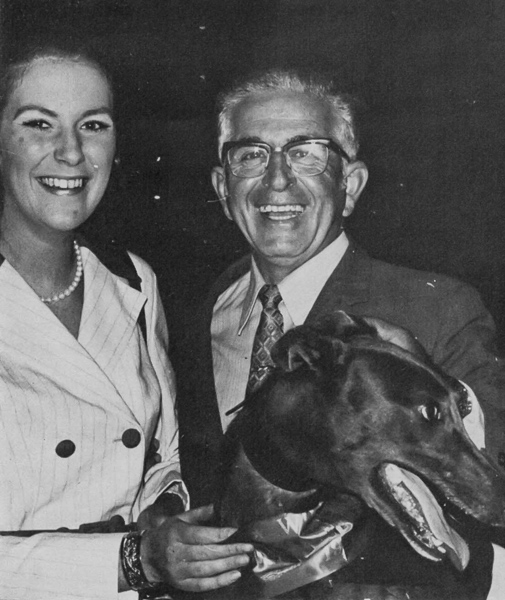
Cliff Abraham with Lorraine Ribbon and
Berry-bank Opal (1971 Hobart Maiden Thousand winner)
Abraham started Tumble Bug’s career at Wyong in N.S.W. on September 2 1946 with a win over 316 yards. His initial 8 starts included another win at Wyong, placings at Harold Park and Maitland, and an Albury victory before two from two at Sandown Park in Melbourne. In early 1947, he ventured back to Tasmania (where the biggest prize money was in those days) and was to have a most injury interrupted 20 starts, which included 15 wins and 3 placings. Despite racing a mere 27 times for 18 wins and 5 placings, the impact Tumble Bug made was instant and electrifying.
A third and a first at White City in Launceston, was followed by a crack at Australia’s premier event, the 1947 Hobart Thousand. From 1/9 second handicap, he won his heat by 15 lengths, nearly catching the lure. His semi victory was the quickest for months, a 29 2/5 seconds by 10 lengths. Some of the newspaper superlatives of his efforts will be covered later. In the “thousand pound to the winner” Final, and despite an early check, he raced clear mid race, only to veer wide on the home turn. This cost him victory by a neck to Young Sign, which ran a new track record of 29 seconds neat. Post race, it was revealed Tumble Bug has dropped a back muscle, which sidelined him for the next 11 months.
Upon resumption, in January 1948, and great credit to Cliff Abraham, the champ was back, seemingly as good as before. A brilliant first up Hobart win, led straight to the Launceston Cup of ’48. Giving two yards start, he blitzed both his heat and semi, but was cleaned up on the first turn in the Final, finishing 5th. Never destined to win the biggest races, he then had his second crack at the Hobart Thousand. Thrashing the mighty NSW chaser My Amorous in his heat, he could only finish a close 4th in the Semi after severe interference.
“Nig” as Abraham called him, was to race 8 more times for 6 wins, including the 1948 Easter Cup at White City, for which he received rave reviews. At 39 months of age, his swansong came at Hobart on April 17 1948, when he broke down after leading (despite 3/9 second handicap) and finished third to Token Minda.
He never raced again, but his star continued to rise due to an astonishing Stud Career across two nations. Here the Part Two of Tumble Bug is taken up from Gary Guccione’s meticulous research.
Tumble Bug it seems, is doomed to a sort of injustice, although it’s not altogether an unenviable one. For time eternal, his name will almost always be uttered in the same breath with that of his at-least equally famous son Rocket Jet and more famous grandson Tell You Why. It is the price an outstanding animal has to pay when he produces such class.
Perhaps no greyhound in history made such an immediate impact in racing, in two different countries, as did Tumble Bug in the late 1940’s and early 1050’s. His greatest influence in both nations, however, would come a generation later when the sons from his son Rocket Jet rewrote Australian record books, then, were united with the Tumble Bug descendants already in America.
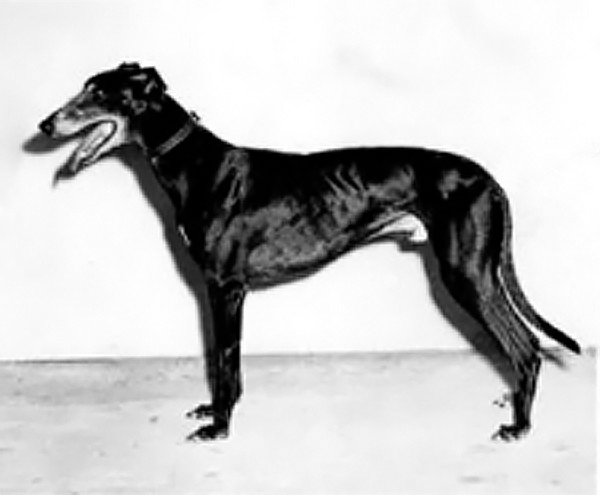
Saddler, the greatest American son of Tumble Bug
Not enough credit can be given to H.W.Shugart, whose importation of Tumble Bug and many other sires that followed, influenced American greyhound breeding like no other event then or since. For all this, Shugart was inducted into the (USA) Greyhound Hall Of Fame in 1981.
Tumble Bug epitomised the traits of the Cinbon line, from which he descended — black, 70lbs and extremely fast. It was not surprising that his most prolific son in Australia (Rocket Jet) and in America (Saddler) were also black and raced at 70 lbs. Tumble Bug hailed from the classic Andrew Micawber male line that produced Just Andrew, Lucky Roll and Handy Andy. The successful blending of all these lines later in America was testimony to the greatness of Andrew Micawber – Australia’s answer to Mutton Cutlet.
Cliff Abraham told Jack Woodward (of the Australian Record publication) “ I selected a magnificent black bitch (Proposed)…….and after a successful but light racing season, I decided this was the bitch to give me the dog I was seeking.” Proposed was mated to Buddha, but Abraham sold the complete litter and spent the next six months seeking out what he considered was the fastest dog in Australia for her second mating. His quest took him to the famous Diamond Creek Kennel in Victoria where Silver Chief, the leading Australian sire was standing. “Luck was with me in this instance, I will admit,” said Abraham, “because the sire I chose for Proposed was not Silver Chief, but Menang, the silver brindle flying machine.” Reportedly, Menang was one of the fastest greyhounds to ever go across an Australian coursing park. His pedigree was loaded with White Hope and The Dickens blood, mostly through Micawber.
When Abraham told his friends of his choice, they told him he was mad, and were definite in their prediction that Menang would never sire a good “tin hare “dog. Abraham was delighted with the litter of eight, and announced that none of the pups was for sale. Considering the initial “madness” or high spirits of the pup, the name Tumble Bug was a perfect choice. At the track, it was soon learned that Tumble Bug was too fast for his own good, and ………as previously mentioned………injuries would cut short his career at 27 starts. His racing greatness was best described by some of the press clippings of that time.
“ Tasmanian Guide” (February 1947): “ Turning in one of the best exhibitions of galloping ever seen at Hobart, Tumble Bug made a one-act affair of his Thousand heat when he bolted in with 15 lengths to spare.”
“The Greyhound Breeder” (February 1947) : “ Heat 19 of the Hobart Thousand caused one of the biggest sensations ever in Tasmania when Tumble Bug …..from 1/9 behind……..put the biggest gap in a field ever witnessed. Tumble Bug led by an estimated 50 yards and won by an official 15 lengths.”
“The Tasmanian Truth” (April 1948) : “ No dog has ever received such a reception as that given to Tumble Bug, winner of the Easter Cup. A Melbourne Cup winner would not have been greeted with more enthusiasm”
“The Tasmanian Truth” (March 1948) : ……..none has surpassed the brilliance of Tumble Bug in the H.G.R.C. Stake last Saturday. From four yards (actually 2/9’s) behind against reputed sprinters and stayers in Young Sign, My Bernborough, Prince Amorous, King Panza etc., he whizzed past them as if they were galloping backwards. Going round the outside if the field he saw daylight up the backstretch and then it was shut the gate…..this run would have won the Thousand by ten lengths. In his present form Tumble Bug would win any race in Australia. We don’t suggest that he would toss Chief Havoc, but he’d make him gallop for his life if he wanted to keep in front.”
That wasn’t the first or last prompting for a match race between Tumble Bug and Chief Havoc, but not long afterward Tumble Bug ruptured a muscle on a hind leg, which ended his racing days. Though the match race never materialized, Tumble Bug and Chief Havoc teamed up years later on the pedigrees of many of their greatest descendants, complimenting each other in a manner that has rarely been paralleled, and which won both of them their highest acclaim as perpetuators of the breed.
When retired, Tumble Bug never attracted the top N.S.W. breeders, even though his fee was only 10 guineas. But it didn’t take long for Tumble Bug to win the same acclaim as a sire that he’d earned as a racer. The demand for Tumble Bug’s services increased – and so did his stud fee, to 12 guineas. After two years at stud, Tumble Bug was one of Australia’s most sought after sires.
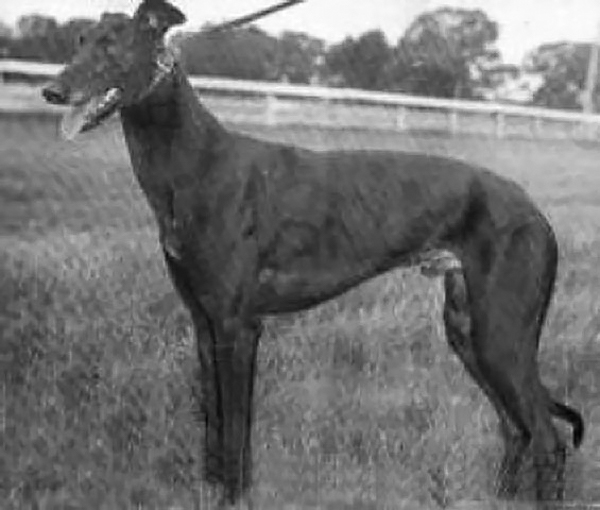
Rocket Jet, Tumble Bug’s most famous Aussie son
During that time, a former travelling salesman from Iowa was diligently researching the bloodlines and race results in Australia. “I studied every race and carried all the statistics out for a whole year,” Shugart recalled years later. “I came to the conclusion that Tumble Bug and Chief Havoc were the two best in Australia. I bought Tumble Bug because his pups were winning as much as Chief Havoc’s, and Chief Havoc was getting the select bitches”
After Shugart’s acquisition of the dog, he received a letter from Abrahams that illustrated the kind of animal Tumble Bug really was. “Finicky” describes it only mildly; It’s this sort of high – strung temperament that characterized a number of the great ones, including many of his own descendants.
Abraham’s “hurried note”………was 21 pages of detail as to how Tumble Bug should be handled…..fed….mated. Shugart followed Abraham’s instructions pretty much to the letter, and Tumble Bug did indeed do well. For a while he stood at stud in Iowa, then in 1950 was in Manhattan, Ks., where the Shugarts had taken up new residence. “Tumble Bug was bred to a lot of nickel bitches, so had a harder time of proving himself here that did some of my later studs, like Tell You Why,” (Tumble Bug’s grandson, and fellow U.S.A. Hall of Famer), Shugart said.
One of Tumble Bug’s first litters in America was out of the Scatter Brain female, No Frenzy. It included Saddler, who is recognized as the best producing Tumble Bug son sired in this country (America)…… Saddler won 14 in 20 trips to post at Hollywood in 1952, including the Hollywood Futurity. The black 70-pounder became a good sire after retirement and lives on primarily through his bitches. By far his two greatest producing daughters were Meanwhile and Westy Kinto. These dams in turn produced two of the greatest racing individuals ever in America — Miss Whirl and Kithed. Miss Whirl produced several excellent litters, including the Air Patrol bunch that included Axe Maker. Kithed sired some excellent pups, including Hollywood Classic winner Enisled and Wonderland great Burnt Wood. Kithed’s sire line offers another cross of Tumble Bug, through Rocket Jet and Tell You Why.
Meanwhile’s sister Edge Of Nite…..also produced several good litters, including the New World bitch Edge O’Fire, mother of All – America Twice As Nice. Saddler’s son Max Star hit paydirt in the 4th Flagler International in 1964 and the $10000 Winner-Take-All Match Series against Wonderland’s Ruston. Saddler’s sister Velvet Ribbon, did her share in perpetuating the Tumble Bug line. She produced Velvet Apron, mother of more than one good Ample Time litter (including) Sky Region, winner of the 1962 Flagler Classic.
With Saddler his only major son sired in America, Tumble Bug primarily produced females to carry on his name after arriving on American soil. One such female was Tiny Bug….most remembered for producing Shirley K., mother of Go Ed and Singing Judy. Other good producing Tumble Bug daughters included Hurricane Carol, Tumble Through (dam of Little Tumbler), Flash Bug (produced the sensational female Vickey’s Bug)…….other Tumble Bug daughters produced well and still live on in the greyhounds of recent times. You’ll find his name in the bitch lines of such Derby stars as D.B.’s Maverick, O.B.’s Private John and Ernest Shamrock. Even some of the better coursing stock remaining in this country usually descends from Tumble Bug, often through one of his fastest sons, Tumbling Pat, who won the 1954 Sarasota Derby, set a 3/8’s mile record, won 14 races in one season, then won the Daytona Inaugural and the Derby.
One of Tumble Bug’s more important sons was All Man. His cross with Austin’s Pride produced the crackerjack bitch Realty. All Man also sired much of the Deep Rock Kennel stock, including Steve’s Rock, Hamms Rock and Fish Rock. Jet Comet, a Colorado ace in the mid 1950’s, was another Tumble Bug son. In the twilight of his breeding career, Tumble Bug sired Tecumseh Tillie, which in turn was dam of top producer Mac’s Lamb.
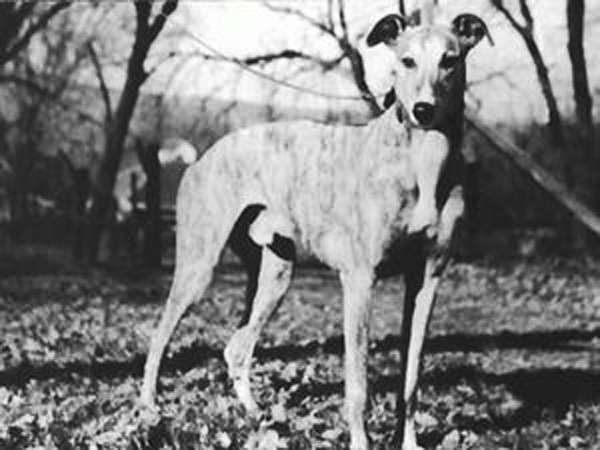
Tell You Why, grandson of Tumble Bug, and fellow U.S.A.Hall of Famer
Tumble Bug died at the age of 11 after developing a heart condition. At the time it must have seemed that, while the Tumble Bug strain would definitely carry on in this country, Tumble Bug might never approach in stature, sires like Mixed Harmony, Lucky Roll, Never Roll or Rural Rube. Perhaps it wouldn’t have, had it not been for one important event.
Just prior to Tumble Bug’s exportation to America, he was mated in Australia to a female named Marnaleen. The litter wasn’t whelped until Tumble Bug had arrived in America. One pup in that litter would later stake claim to a breeding strain all his own, one that would overshadow the feats of his dad. In later years, his offspring would arrive on our shores to totally restructure the bloodline patterns in this nation. The pup’s name, of course, was Rocket Jet.
In nearly every instance of success with Tumble Bug in America, his descendants were crossed back to the Tumble Bug line again, through Rocket Jet. While stars such as Tuf Miler, Trap Rock, Watch Harvey, Milt Spencer, P.L.Greer, Miss Gorgeous, Kithed, Purple Onion, Go Ed, J.W.Heston, Mr. Scooter, Go Willie Wang, A.H.Willy, Fearless, Fast Company and Great Escape all have Tumble Bug in their bitch lines,, they also have Tumble Bug through their sires, via Rocket Jet. So it wasn’t until several years after his death, did America become fortunate enough to receive from Australia the true cream of the Tumble Bug crop.
For proponents of linebreeding, the Tumble Bug story is provocative, almost romantic. Here was a sire who came to this country to build a foundation through his female descendants in preparation for the importation of his male-line posterity a generation later. Tumble Bug indeed helped pioneer the modern–day breed in this country, because the eventual mingling of his American female line and his Aussie male line a generation later, produced many of America’s most renowned greyhounds. Were it not for the latter importation of Tumble Bug blood through the Rocket Jet strain, chances are Tumble Bug would be just another sire in America’s past.
How appropriate that the instrument behind the importation of both Tumble Bug and his grandsons years later was the same Mr. Shugart! His foresight and allegiance to the value of good bloodlines and linebreeding have probably done more for the greyhound breed in this country (America) than the efforts of any other man in the last 35 years. His Hall Of Fame induction (1981) was appropriate – even warranted.
Gary Guccione’s in depth assessment of the Tumble Bug influence was followed by chapters on his freaky son Rocket Jet, and similarly exceptional grandson Tell You Why. The latter won the Harold Park Classic, Bi- Annual Classic and was inducted into the American Hall Of Fame in 1978 for his amazing deeds as a sire in that country. Rocket Jet was purchased for huge money by Australian Hall of Fame trainer Stan Cleverley after his initial two wins. He held five track records at the one time and was one of the legendary sires in Australian greyhound history.
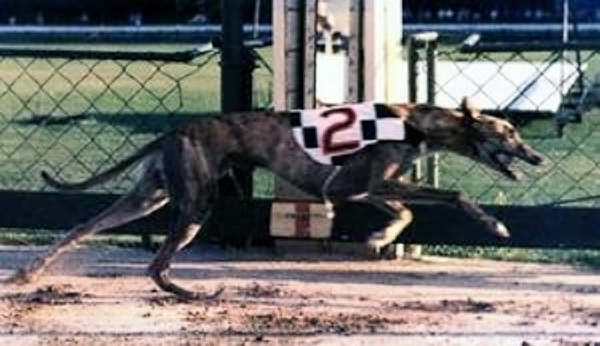
Famous 70’s racer and super sire Temlee, traces back to Tumble Bug
Tumble Bug’s story is a like a fairytale, indeed, it seems more fanciful. Born and primarily raced in Tasmania, he had a tumultuous upbringing and racing career, cut short by crippling injury, followed by a Stud career that shaped the breeding history of two great nations. The wonder dog, Temlee, whelped in 1972 traces back to Tumble Bug through his dam Temora Lee. Now, an amazing seventy years after Tumble Bug’s birth, some of the biggest names in Australia today………the likes of Miata, Barcia Bale and Shakey Jakey, can be traced back to Tumble Bug. Most humbly, we rightfully add to Tumble Bug’s own private Honour Roll, a place in Tasmania’s Greyhound Hall Of Fame.
